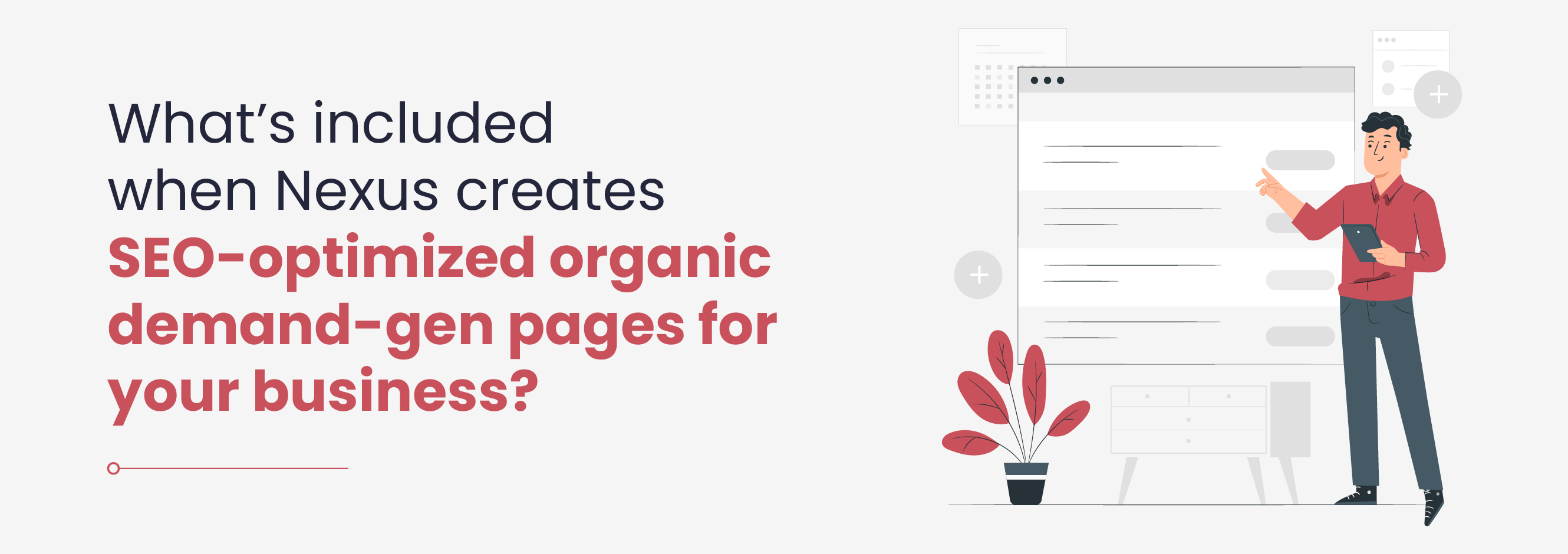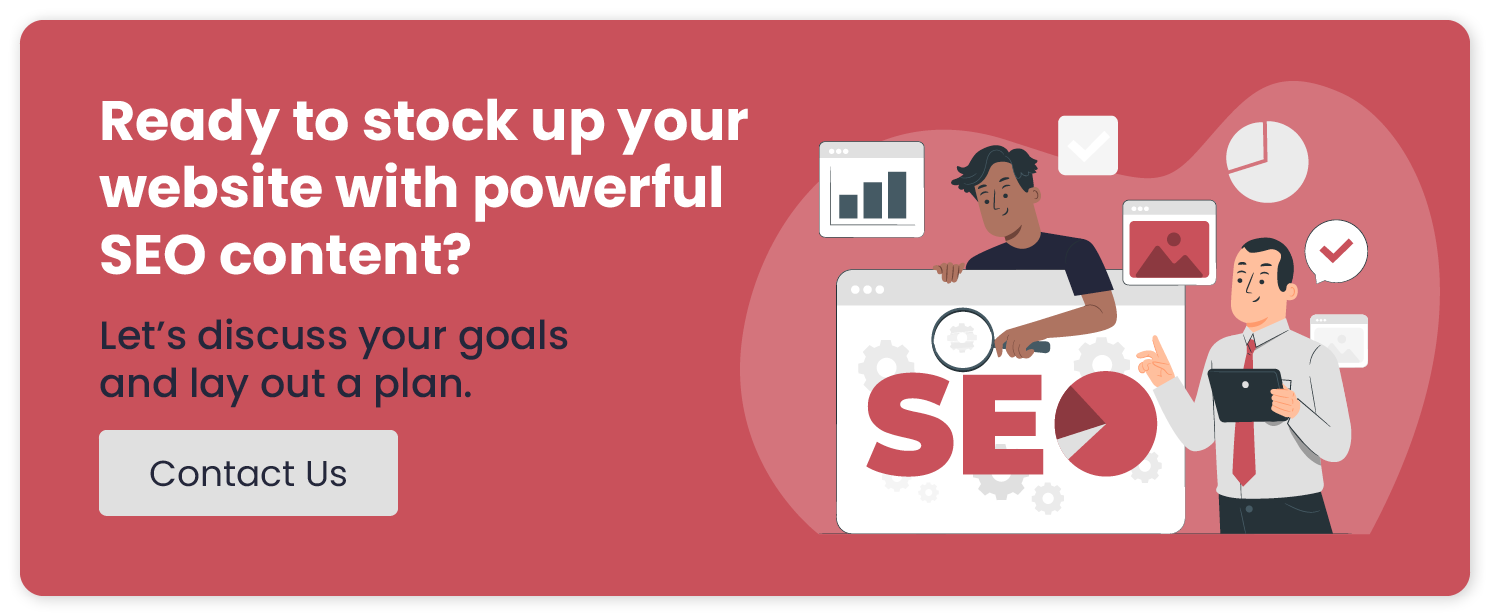
What all do you get in an SEO-optimized landing page or article from Nexus Marketing?
What are the built-in SEO strategies that your team, an outside writer, or ChatGPT might not know to include?
Nexus SEO-optimized landing pages and longform content are much more than words on a screen—we tailor each article to your brand, lead generation goals, and the unique SEO contexts of your target keywords.
Clients often ask us about the difference that they can expect from our content team’s articles and whether AI-generated content is worth producing. A lot goes into creating high-quality, high-ranking, lead-generating content, so we’ve rounded up our thoughts in this comparison resource:
Our recommendation: For content intended to rank for target keywords and generate leads, we recommend that clients use Nexus-written landing pages and longform articles or use Nexus-developed content strategies to write their own. AI should be avoided for SEO content creation except for help with early ideas and outlines.
Content Strategy
These technical elements ensure that Google can easily understand (and will want to rank) your content and, when consistently followed, will set your entire website up for long-term SEO success.
Key
✔️ – Always 🟡 – Sometimes
⭕ – Rarely ❌ – Never
| Analysis of Google’s current results and user goals for that keyword | To rank, content must be designed to fit with Google’s current understanding of the keywords and what people’s goals are when searching them based on analyzing current search engine results. |
✔️ |
⭕ |
❌ |
| Designed to satisfy Google’s EEAT guidelines | To rank, content needs to demonstrate Experience, Expertise, Authoritativeness, and Trustworthiness according to Google’s guidelines by being comprehensive, highly relevant, and linked to by third-party sources. |
✔️ |
⭕ |
❌ |
| Custom image creation tailored to the content | High-quality, custom images improve overall page performance by signaling value and relevance to users, increasing time on page and encouraging additional links. |
✔️ |
⭕ |
❌ |
| Inclusion of special tactics to maximize visibility in other Google results features | Definitions, FAQs, and lists can be strategically included to appear in Google’s “featured snippet” and “people also ask” features, securing additional visibility for the content on results pages. |
✔️ |
⭕ |
❌ |
| Language tailored to brand, audience, and sales funnel position | Language and subject matter must strike the balance of representing the brand, appealing to the audience, and being relevant to their current point in the buying journey. |
✔️ |
🟡 |
❌ |
| Optimal length compared to competing content | To rank, content must include the same amount or more detail than the pages that are currently ranking in top results spots. |
✔️ |
🟡 |
⭕ |
| Subject matter research and third-party citations | Subject matter expertise, links, and citations signal authoritativeness and trustworthiness to both Google and users. |
✔️ |
🟡 |
⭕ |
| (For offsite content) Approach tailored to ensure publishing by third party | Offsite posts must be written with the publishing partner’s brand and goals in mind to ensure that they will be published with all valuable links intact and links will transfer appropriate SEO value. |
✔️ |
⭕ |
❌ |
Analysis of Google’s current results and user goals for that keyword
Why it Matters:
To rank, content must be designed to fit with Google’s current understanding of the keywords and what people’s goals are when searching them based on analyzing current search engine results.
Nexus Content ✔️
Non-Nexus Content ⭕
ChatGPT Content ❌
Designed to satisfy Google’s EEAT guidelines
Why it Matters:
To rank, content needs to demonstrate Experience, Expertise, Authoritativeness, and Trustworthiness according to Google’s guidelines by being comprehensive, highly relevant, and linked to by third-party sources.
Nexus Content ✔️
Non-Nexus Content ⭕
ChatGPT Content ❌
Inclusion of special tactics to maximize visibility in other Google results features
Why it Matters:
Definitions, FAQs, and lists can be strategically included to appear in Google’s “featured snippet” and “people also ask” features, securing additional visibility for the content on results pages.
Nexus Content ✔️
Non-Nexus Content ⭕
ChatGPT Content ❌
Language tailored to brand, audience, and sales funnel position
Why it Matters:
Language and subject matter must strike the balance of representing the brand, appealing to the audience, and being relevant to their current point in the buying journey.
Nexus Content ✔️
Non-Nexus Content 🟡
ChatGPT Content ❌
Optimal length compared to competing content
Why it Matters:
To rank, content must include the same amount or more detail than the pages that are currently ranking in top results spots.
Nexus Content ✔️
Non-Nexus Content 🟡
ChatGPT Content ⭕
Subject matter research and third-party citations
Why it Matters:
Subject matter expertise, links, and citations signal authoritativeness and trustworthiness to both Google and users.
Nexus Content ✔️
Non-Nexus Content 🟡
ChatGPT Content ⭕
(For offsite content) Approach tailored to ensure publishing by third party
Why it Matters:
Offsite posts must be written with the publishing partner’s brand and goals in mind to ensure that they will be published with all valuable links intact and links will transfer appropriate SEO value.
Nexus Content ✔️
Non-Nexus Content ⭕
ChatGPT Content ❌
SEO & Technical Strategy
When built into articles from the outline stage to the published page, these content strategy elements ensure that content can compete with and outrank other pages on the internet.
Key
✔️ – Always 🟡 – Sometimes
⭕ – Rarely ❌ – Never
| Inclusion of relevant external links | Including links to relevant, trusted sources signals authority and trustworthiness to Google, which helps boost rankings. |
✔️ |
⭕ |
❌ |
| Inclusion of strategic internal links | Building links to other content on the same domain improves overall domain health and performance by directly telling Google what the pages are about. |
✔️ |
🟡 |
❌ |
| Optimized meta descriptions | Content should include a meta description (the snippet that appears under the title on results pages) that is optimized for both the keyword and to entice more clicks from users. |
✔️ |
⭕ |
⭕ |
| Optimized heading structure | Content should include headings and section labels that follow an intuitive order and include strategic keyword variants in order to rank. |
✔️ |
🟡 |
⭕ |
| Optimized images | Images must be optimized for size, lazy-loading, and quality to prevent long load times that will hamper ranking performance. |
✔️ |
⭕ |
❌ |
| Optimized URL structure | Content’s URL should be optimized for the keyword and the site’s overall structure. Redirects should be implemented if needed to improve the URL and keep the site organized. |
✔️ |
⭕ |
❌ |
| Mobile usability testing | To rank, content should be made accessible for mobile users by using optimized image files and identifying any sitewide issues that need addressing. |
✔️ |
⭕ |
❌ |
| Optimized alt text for graphic elements | The alt text included for graphic elements should be optimized to include keywords, improve the user experience, and boost the page’s overall accessibility. |
✔️ |
⭕ |
⭕ |
| (For offsite content) Strategic inclusion of links based on current SEO goals | To provide SEO value, offsite posts should include links to target pages using strategic and carefully framed anchor text that ensures third-party websites will publish them. |
✔️ |
⭕ |
❌ |
Inclusion of relevant external links
Why it Matters:
Including links to relevant, trusted sources signals authority and trustworthiness to Google, which helps boost rankings.
Nexus Content ✔️
Non-Nexus Content ⭕
ChatGPT Content ❌
Inclusion of strategic internal links
Why it Matters:
Building links to other content on the same domain improves overall domain health and performance by directly telling Google what the pages are about.
Nexus Content ✔️
Non-Nexus Content 🟡
ChatGPT Content ❌
Optimized meta descriptions
Why it Matters:
Content should include a meta description (the snippet that appears under the title on results pages) that is optimized for both the keyword and to entice more clicks from users.
Nexus Content ✔️
Non-Nexus Content ⭕
ChatGPT Content ⭕
Optimized heading structure
Why it Matters:
Content should include headings and section labels that follow an intuitive order and include strategic keyword variants in order to rank.
Nexus Content ✔️
Non-Nexus Content 🟡
ChatGPT Content ⭕
Optimized images
Why it Matters:
Images must be optimized for size, lazy-loading, and quality to prevent long load times that will hamper ranking performance.
Nexus Content ✔️
Non-Nexus Content ⭕
ChatGPT Content ❌
Optimized URL structure
Why it Matters:
Content’s URL should be optimized for the keyword and the site’s overall structure. Redirects should be implemented if needed to improve the URL and keep the site organized.
Nexus Content ✔️
Non-Nexus Content ⭕
ChatGPT Content ❌
Mobile usability testing
Why it Matters:
To rank, content should be made accessible for mobile users by using optimized image files and identifying any sitewide issues that need addressing.
Nexus Content ✔️
Non-Nexus Content ⭕
ChatGPT Content ❌
Optimized alt text for graphic elements
Why it Matters:
The alt text included for graphic elements should be optimized to include keywords, improve the user experience, and boost the page’s overall accessibility.
Nexus Content ✔️
Non-Nexus Content ⭕
ChatGPT Content ⭕
(For offsite content) Strategic inclusion of links based on current SEO goals
Why it Matters:
To provide SEO value, offsite posts should include links to target pages using strategic and carefully framed anchor text that ensures third-party websites will publish them.
Nexus Content ✔️
Non-Nexus Content ⭕
ChatGPT Content ❌
We’re proud of our copywriting team—all academic superstars who’ve made it through rigorous selection and SEO training processes. With years of experience in content marketing strategy development, SEO, and the mission-driven subject matter that your audience is seeking, our team can help you achieve your organic search and lead generation goals.
Have any questions about this resource or the strategies and tactics included above? Please reach out to your account manager or copywriter—we’ll be happy to discuss them with you!



